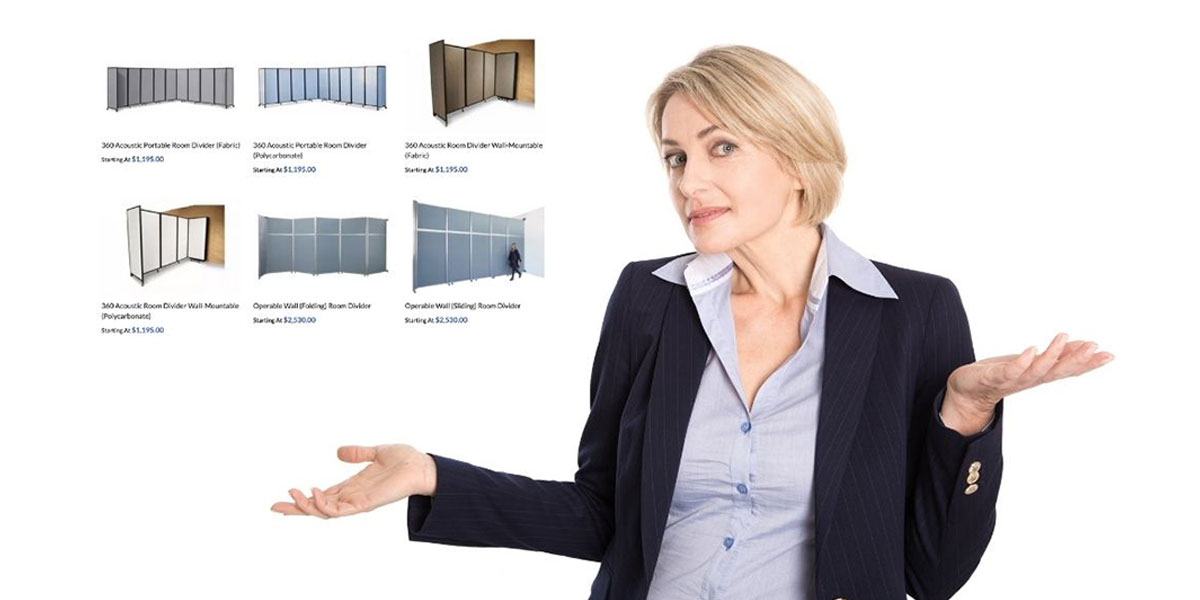Office partitions are a versatile and highly customisable solution to a problem plaguing many corporate buildings: optimising office space.
But choosing the right office partitions is not always easy. And your choice of partitions can be the difference between offering your employees a healthy, comfortable and productive space, or leaving your staff feeling cramped, uninspired and frustrated.
Below, we’ve included a simple guide for how to choose the right office partitions to suit your needs.
Questions to ask yourself before you install office partitions
Before choosing your office partitions, there are some questions you’ll need to ask yourself. These can help you determine which material, size, shape and style is most suitable for you.
Do your partitions require noise controlling properties?
The size, shape and material you choose for your office partitions can have a real impact on the way sound works in the office. It’s important to analyse your sound performance requirements, and assess your space before making a decision. Large rooms, for example, can amplify noise as the sound bounces off hard surfaces. Such rooms typically require sound dampening technology to help reduce reverberation and muffle sound.
A partition fitted with acoustic fabric is an excellent option for dampening sound within a large room, but won’t necessarily prevent sound from making its way to the other side of the divider.
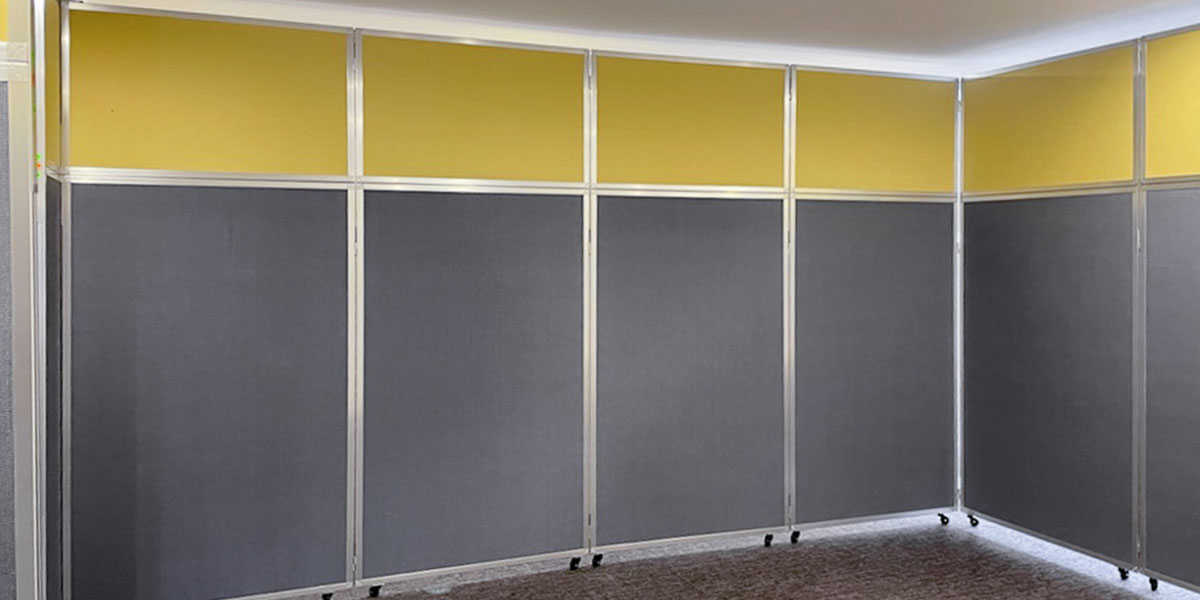
Polycarbonate or double glazed glass partitions, on the other hand, have no sound dampening qualities at all. In fact, they may even increase reverberation within the space. However, by reflecting sound, this style of partition helps to prevent voices and other noises from making their way to the other side of the wall. This offers a more private space, while also helping to prevent distracting external noises from entering the room.
The height of your partition can also influence its ability to control sound. Taller operable walls and floor-to-ceiling solutions, for example, offer superior sound performance and privacy.
How important is flexibility and customisation to your solution?
How much you want to be able to customise your office layout is an important factor to consider before choosing a partitioning solution.
While solid wood partitions and heavier walls may be visually appealing and offer greater sound control, their weight and size typically comes at the cost of portability. Similarly, ceiling partition walls are a stylish and highly functional option, but, as they’re restricted to a single track, there’s not much room for customisation beyond opening and closing the partition.
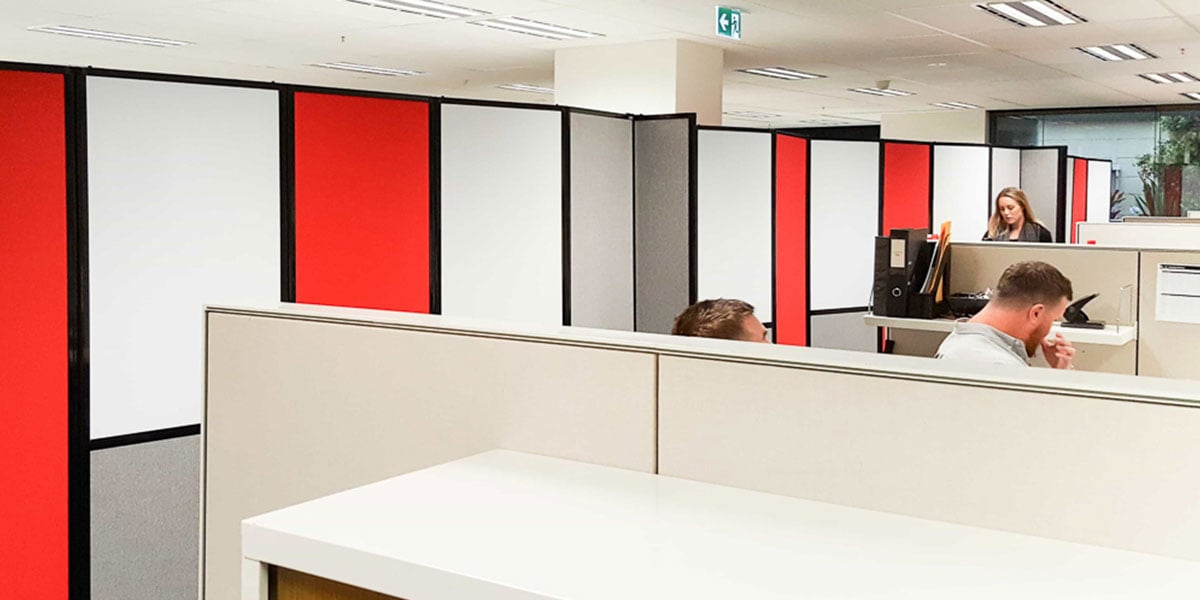
If customisation is an important factor, the more flexible and highly adaptable construction of freestanding room dividers may be a more suitable option. Often coming with wheels and made from lighter materials, this style of partition can be moved throughout the space, and are particularly useful in an open plan office setting. However, this high level of portability comes at the cost of sound control and a complete, floor-to-ceiling construction.
Consider the interior design of your office
Your preferred office design can have a big impact on what type of office partitions you need. Choosing the right colours to suit your specific aesthetic, for example, can really help to set the tone of your working environment. In fact, certain colours have even been found to impact employee mood and enhance productivity.
More neutral tones, which are popular in many modern offices, often create a more stylish look, but can sometimes create an uninspiring or ‘stale’ office environment. Shades of blue create a more soothing and peaceful space, and can be particularly suitable for offices that require focus and mental strain. Red, on the other hand, is considered an energetic colour which can inspire action, but may also increase stress in the workplace. Such a strong colour is more suited to areas that require physical exertion, such as a gym, rather than an office space.
Purchasing pinnable fabric partitions also offers greater freedom for personalisation. By pinning pictures, photos and notes directly onto the partition, staff can customise their work environment and create a warmer and more friendly team atmosphere.
What do you need out of your office space?
What office partition is going to suit you best depends on what you need from your space.
If you only need the occasional space for private collaboration, perhaps a more portable solution that can be packed away when not in use is the most suitable option.
However, if you regularly require a space for private meetings, perhaps a permanent or semi-permanent solution, such as ceiling or wall-mountable operable walls are better suited to your needs.
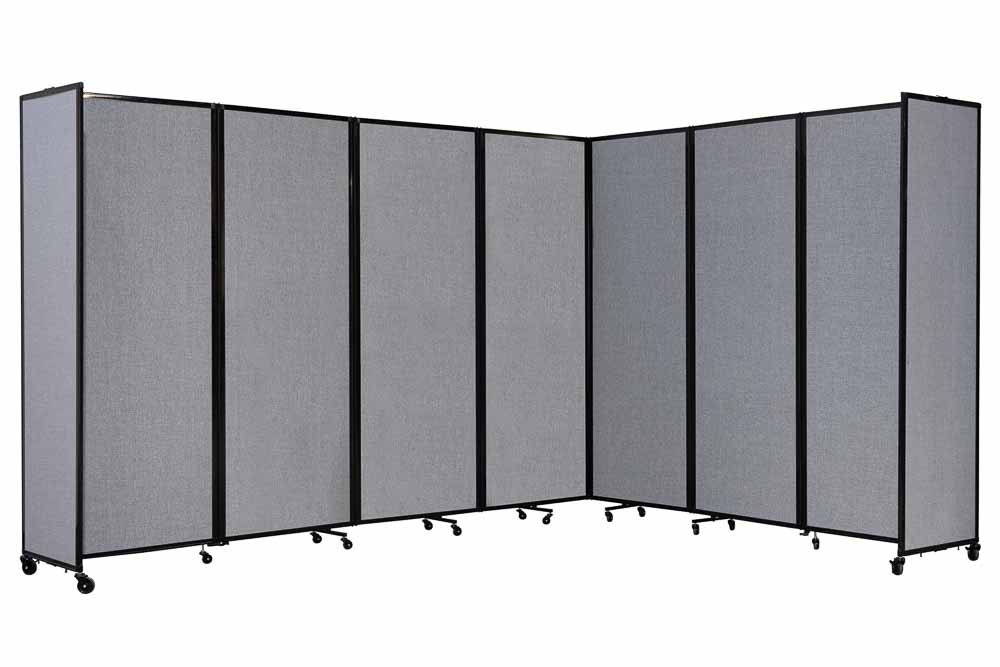
If you’re looking to set up standard office spaces, a network of cubicles can enhance privacy, dampen sound and reduce distractions, while helping to increase comfort for employees. Office cubicles range from heavy, fitted cubicles to lighter, modular cubicles that feature a simple panel and post system for greater customisation.
Does portability matter to you?
Before choosing your partitions, you’ll first need to determine whether portability is a priority for you.
If portability isn’t a factor in your decision-making process, fixed partitions may be the right option for you. Installing a solid structure, such as double-glazed glass or timber partitions can offer an attractive and effective method of dividing up your space. Glass is also a particularly good option if you want to create a sound barrier while retaining that open office feel.
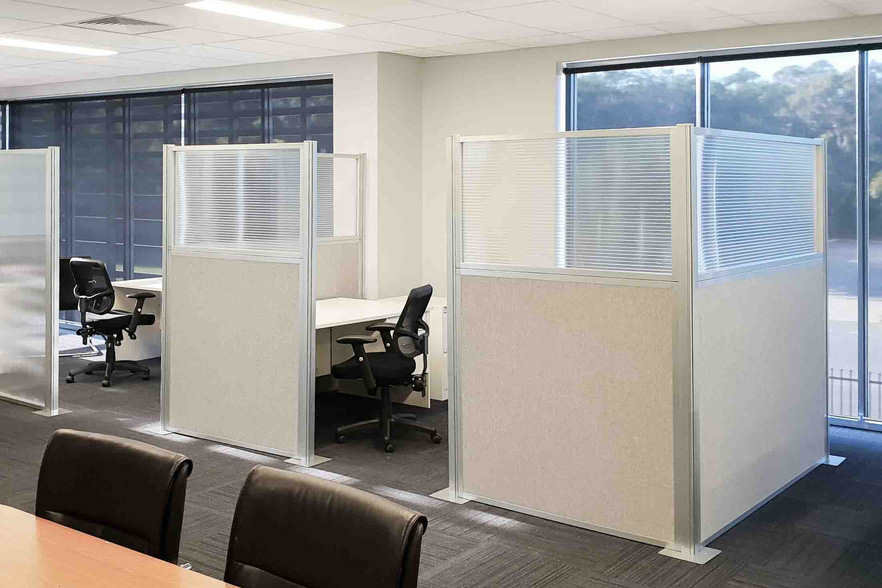
The next step from fixed partitions are ceiling-mounted partition walls. Such walls are mounted to a track on the roof, so they can slide open and closed, allowing you to temporarily divide your open office space. Featuring a floor-to-ceiling design, ceiling-mounted operable walls deliver superior sound dampening qualities and enhanced privacy.
Easier to install and more portable than ceiling-mounted walls, demountable operable walls can be fixed to your wall in just minutes. However, it’s important to note that the increased portability of this style of partition comes at the expense of some acoustic performance and complete floor-to-ceiling coverage. Due to their sturdier, wall-mounted design, demountable operable walls can be built taller than completely freestanding partitions, so they typically offer better privacy and sound-controlling qualities.
Finally, for complete control and portability, freestanding partitions give you the ability to customise your office layout in moments to create instant privacy. Freestanding partitions generally feature wheels and are made with lighter materials for extreme portability. They range from large room dividers to smaller partition screens, and can be placed anywhere in the room, or packed down to a narrow footprint for easy storage. It’s important to note that this high level of portability means that these partition screens are less capable of controlling noise levels than other partitioning solutions.
Are you working from a rented space?
How much you can customise your working space is often dependent on whether or not you own the building.
Quite often, running a business from a rented space can seriously restrict how much you can customise your office layout. In these situations, fixed or ceiling mounted partitions may not be a suitable solution.
However, there are many more portable solutions on the market that can either be mounted to the wall with a few simple bolts and brackets, or are completely freestanding. Such partitions are usually more appropriate for rented spaces and come with the added benefit of travelling with you if you ever move to a new building.
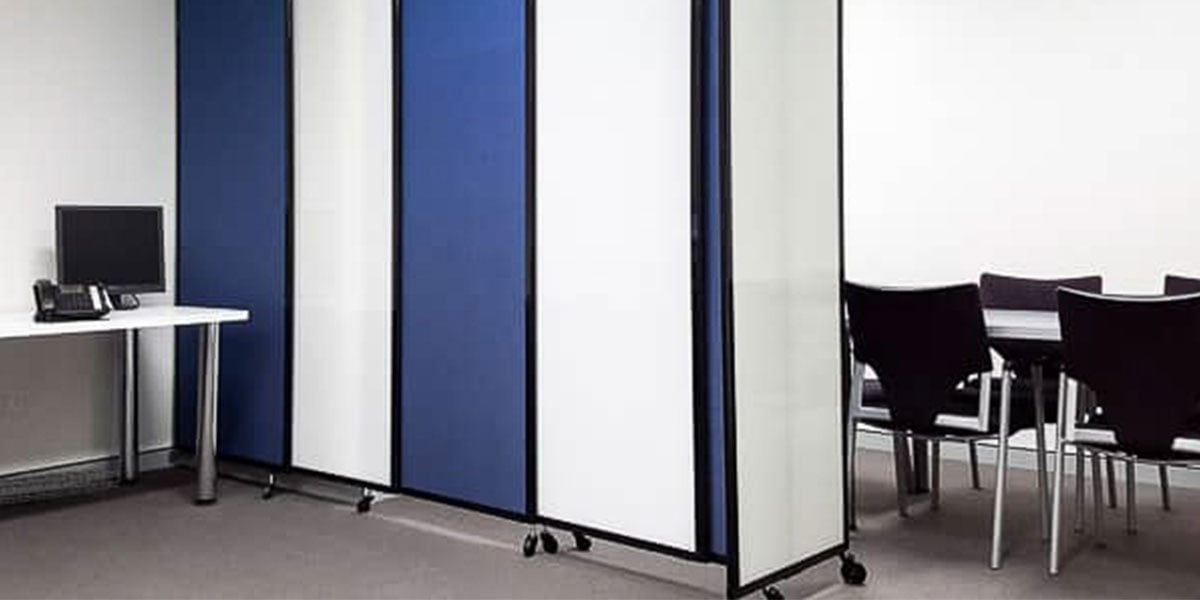
What’s your budget?
The big question. What is your budget?
While portable partitions are typically a more cost effective solution than major installations and permanent walls, a tight budget may still restrict what you can purchase.
For example, while ceiling-mounted partitions are a stylish and effective partitioning system, long build times and the need for runners and support beams means that they require professional installation. This can drive up your costs from thousands to tens of thousands of dollars, and extend the build time from weeks to months.
If this is a bit beyond your budget, you may need to look at more cost effective solutions.
The good news is, this doesn’t necessarily mean you’ll need to buy cheap or low quality partitions. You may just need to find more adaptable solutions that offer maximum functionality. For example, rather than purchasing a single mounted partition, you may instead choose a freestanding room divider which can be moved around your space and set up wherever and however you need it.
The greater the adaptability, the fewer partitions you’ll need to purchase and the lower your costs.
Maintenance and cleaning
Depending on your space, one form of partition material may be more suitable than another, so it’s important to decide where you’ll be using your partitions before purchasing them.
For ‘wet’ areas or places where people will be eating or drinking, polycarbonate or glass partitions may be a more suitable option, as they’re easy to wipe down and keep clean. This can make it easier to protect employee health and maintain a hygienic workplace. Fabric, on the other hand, is harder to clean, soaks up liquids and may end up covered in unsightly stains.
When selecting your partition walls, it’s always best to consider the purpose of the room before deciding upon your material.
Who will be operating the partitions?
Who will be operating your partitions can influence what style of partition you should install.
Some partitions are harder to operate than others. For example, heavier partition dividers or ceiling-mounted operable walls can not only be physically more difficult to move about the space, they can also take longer to set up and pack away, and may even require multiple people to operate. Typically, you can expect better noise control and privacy from this style of partition, but if a speedy set up and ease-of-use is a priority, this may not be a practical solution.
Highly portable wall partitions, on the other hand, such as freestanding room dividers, are typically made of lighter materials and are much easier to move, operate and pack down. This high level of portability means that this style of partition can be set up and packed away in just moments, and can be easily operated by just one person. This makes portable partitions an ideal option for spaces where speed and ease-of-use is paramount.
How will you be using your partitions?
Identifying how you intend to use your partitions is an important aspect of the decision-making process.
For example, if you intend to hide a printing or storage area, then a clear glass partition is unlikely to be a practical option for your business. In this case, partitions made from fabric, frosted glass, or polycarbonate will offer a better visual barrier.
If you’re looking to offer a space for collaboration and meetings, whiteboard partitions that allow you to write and draw directly onto the surface would be an excellent way of enhancing brainstorming sessions. Similarly, pinnable fabric partitions can allow teams to pin notes and images up as a visual aid during business meetings.
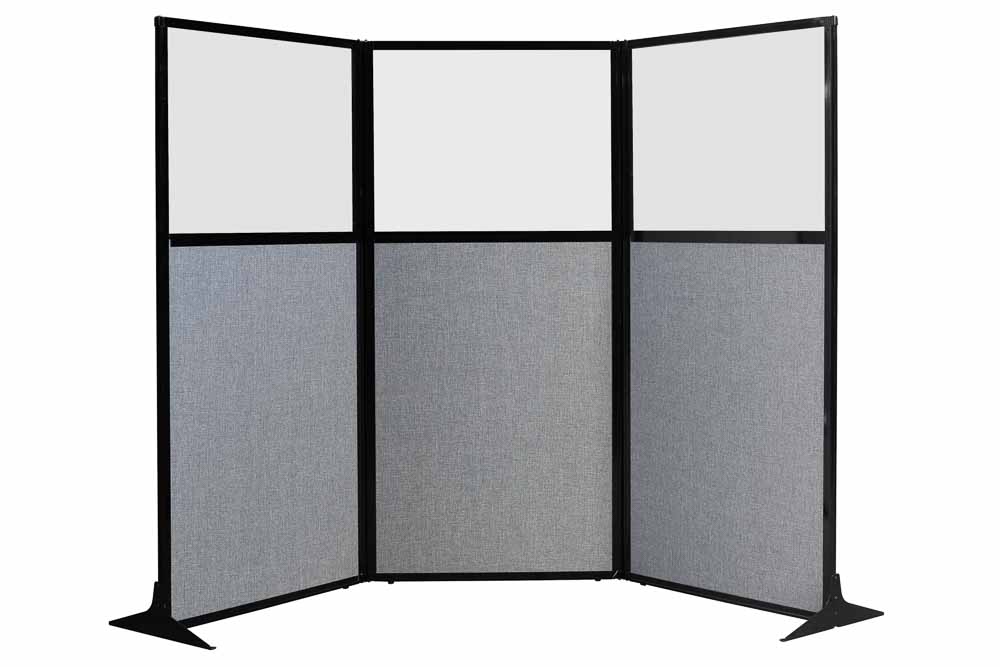
Before making any purchases, it’s a good idea to sit down with your teams and discuss what features and functionality they most want from your space. Consider writing a list of ‘needs’ and ‘wants’ to help you find the solution that ticks the most boxes.
Have you got a deadline?
Not all styles of partition will be functional within a few days or even a few weeks. In fact, some partitions, such as fixed partitions and ceiling-hung operable walls are not only more expensive, they can also take months to install.
That’s why it’s important to be realistic about your time constraints.
If a fast installation is critical to your operations, then perhaps a more portable solution, such as freestanding partitions, demountable operable walls or modular cubicles are your most viable option. That’s because many portable partitions can be installed in minutes without the need to hire professional builders. With most of the wait-time in the delivery, you can be up and running in less than a week.
Consider your timeline and be realistic about how quickly your chosen partitions will take to install. If your business doesn’t have a deadline, and you can afford the longer wait times, then fixed or permanent solutions can be an excellent option. But if you need your partitions functioning quickly, it’s best to choose something that’s quick to set up.
Looking to set up your space with portable partitions?
With so many options to choose from, selecting the right office partitions for your space can feel a bit overwhelming. But by taking the time to consider your needs, budget and space, you’ll be able to identify the perfect partitions for you.
Check out our wide range of partitioning solutions to see what options are available to you!





